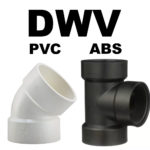
PVC DWV (Drain-Waste-Vent) and ABS DWV are two common types of plastic piping used in plumbing systems, particularly for drainage, waste, and venting applications. While they share some similarities, they also have distinct differences in terms of material composition, properties, and applications:
PVC DWV (Polyvinyl Chloride Drain-Waste-Vent):
- Material: PVC DWV pipes are made from polyvinyl chloride, a thermoplastic polymer known for its durability and chemical resistance. PVC pipes are rigid and commonly come in white or gray colors.
- Properties:
- Lightweight: PVC pipes are lightweight and easy to handle, making them convenient for installation.
- Chemical resistance: PVC is resistant to corrosion from acids, bases, and other chemical agents commonly found in drainage and waste systems.
- Smooth interior: PVC pipes have a smooth interior surface, which helps to prevent clogs and improve flow efficiency.
- Pros:
- Cost-effective: PVC DWV pipes are generally more affordable than other materials, making them a cost-effective option for plumbing projects.
- Easy installation: PVC pipes can be easily cut, joined, and installed using solvent cement, making them suitable for DIY installations.
- Cons:
- Temperature limitations: PVC pipes have lower temperature tolerance compared to ABS pipes, limiting their use in high-temperature applications.
- Brittle: PVC pipes can become brittle over time, especially in cold climates, which may increase the risk of cracking or breakage.
ABS DWV (Acrylonitrile Butadiene Styrene Drain-Waste-Vent):
- Material: ABS DWV pipes are made from acrylonitrile butadiene styrene, a thermoplastic polymer known for its toughness and impact resistance. ABS pipes are black in color and have a slightly softer feel compared to PVC pipes.
- Properties:
- High temperature resistance: ABS pipes have better temperature resistance compared to PVC pipes, making them suitable for hot water and high-temperature applications.
- Impact resistance: ABS pipes are more resistant to impact and physical damage compared to PVC pipes.
- Excellent flow characteristics: ABS pipes have a smooth interior surface that promotes efficient flow and minimizes the risk of clogs.
- Pros:
- High-temperature tolerance: ABS DWV pipes can withstand higher temperatures than PVC pipes, making them suitable for hot water and venting applications.
- Durable: ABS pipes are more resistant to physical damage and impact compared to PVC pipes, reducing the risk of breakage during installation and use.
- Cons:
- Cost: ABS DWV pipes are typically more expensive than PVC pipes, which may affect overall project costs.
Popularity: The popularity of PVC DWV vs ABS DWV pipes can vary depending on factors such as regional preferences, building codes, and specific project requirements. PVC DWV pipes have traditionally been more popular due to their affordability, ease of installation, and widespread availability. However, ABS DWV pipes are gaining popularity in applications where high-temperature resistance and durability are critical, such as commercial and industrial plumbing systems. Ultimately, the choice between PVC DWV and ABS DWV pipes depends on factors such as cost, temperature requirements, and project specifications.

